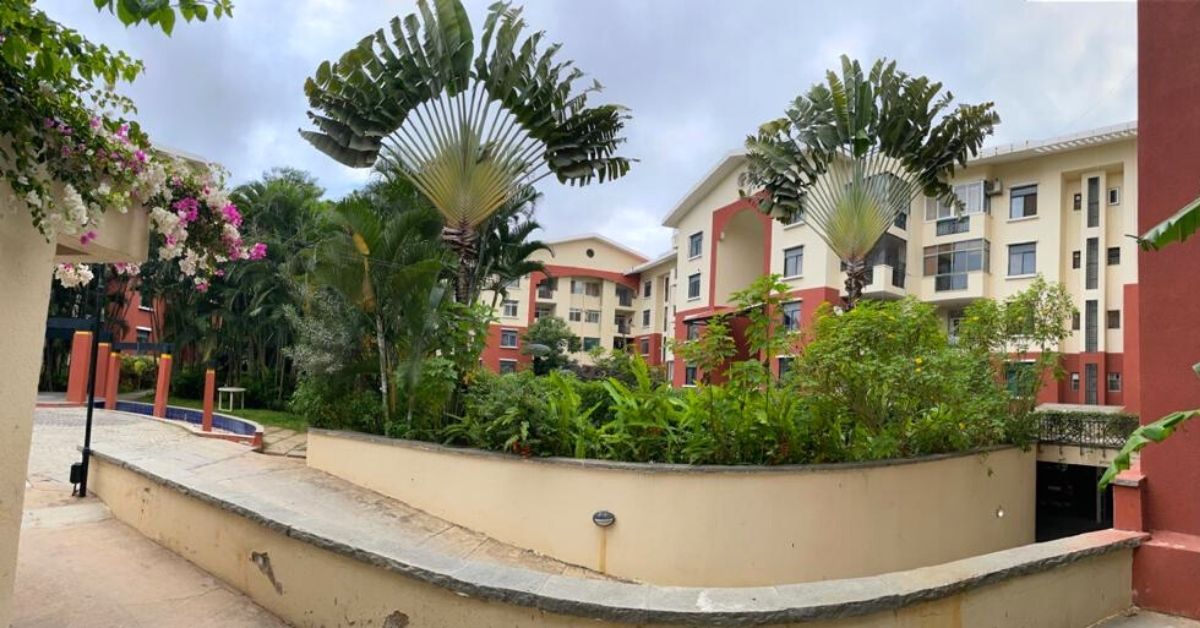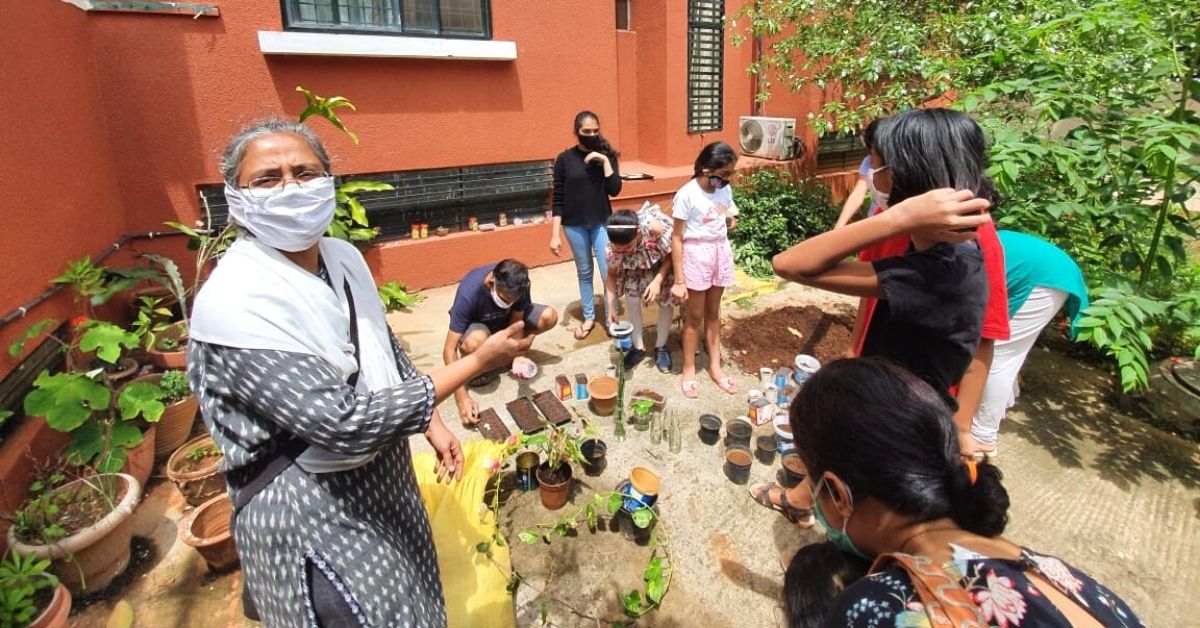Society Grows Its Own Food Forest at Zero Cost, Saves Rs 1.5 Lakh
An eco-friendly society in Bengaluru, SJR Redwoods has grown its own food forest. It also sells compost made with tonnes of leaf litter

A usual sight in any residential society sometimes includes a clubhouse, swimming pool, recreational area, a series of buildings and some trees planted for aesthetic value surrounding these concrete structures.
And the visual landscape for the 152 house SJR Redwoods residential society spread across 5-acre land in Sarjapur, Bengaluru, was no different.
On the other hand, the condition of the neatly pruned aesthetically pleasing plants was deteriorating. “We did not have the budget allocated for our garden department for two years,” says Kavitha Kishore, a resident and member of its gardening team.
However, the COVID-19 lockdown threw an opportunity to try a different approach when the residential committee changed, bringing new members on board.
Kavitha, an environmentalist, says the new members decided to take a new approach to treat the organic waste and adopt a more natural strategy towards the environment.
The move has helped the residential society create a food forest in the middle of their 2-acre common land, enabling residents to pluck herbs, smell the fragrance of fresh flowers, admire the biodiversity and co-exist with nature.
An inspiring citizen movement

“We had no budget to spare and decided to create a zero-budget model where we would not require the residents to spend even a single rupee for our project,” she tells The Better India.
The residents organised multiple workshops to create awareness among the locals. The experts trained them to make plant nurseries and prepare seed banks. “We propagated plants and saplings from existing trees which already existed on the campus. We used seeds from fruits consumed at home to grow saplings of jackfruit, mango and other varieties,” she says.
Today, they have papaya, banana, guava, custard apple and mango trees on the premises. Other native tree varieties planted by the residents include neem, jamun, cherry tree, palms, bamboo, sugarcane, etc.
“We also have a collection of edible herbs such as holy basil, giloy, balloon vine, Thai basil and bishop’s weed. The residents also experimented with growing tomatoes, bitter gourd, spinach, yam and sweet potatoes,” Kavitha shares.
The residents chose flowering varieties such as sunflower, rose, jasmine, Asian pigeon wings (aprajita) and red hood plants. The combination added aesthetic value and helped achieve a balance of trees, shrubs, climbers and herbs growing simultaneously in the area.
Additionally, the residential society, which, earlier, collected its leaf litter from the premises and handed it over to the local body for disposal, started treating it to produce compost. “We created four netted zones, putting leaf litter in them and allowing them to decompose. The remaining leaf matter worked as mulching for the plants,” Kavitha says.
The effort has helped the residential society to prevent 6 tonnes of garden waste from entering the landfill, she claims.
Each compost zone yielded 100 sacks of compost each quarter, which helped rejuvenate the soil. “Instead of adding to the expenses, the effort helped us save Rs 1.5 lakh. There were no vehicles carrying garbage out of the premises, which made us feel proud,” Kavitha says.
Sameer Shisodia, another core committee member of the gardening team, says other team members such as Matilda, Shalini Jain and Indu Iyer also contributed to the cause.

“The members took responsibility to organise various workshops. I used my experience in permaculture and natural farming to design and introduce plant species. While Kavitha helped bring more forest-friendly practices and pushed to reduce the use of chemical fertilisers and pesticides and increase biodiversity,” Sameer explains.
The other members helped conduct awareness on Kokedama, a Japanese Bonsai planting method to increase green landscape and raise awareness among the younger generation.
The overall outcome of the initiative led to a denser and greener space. “Our plants in residential premises became less susceptible to pest and fungal attacks. Biodiversity like dragonflies, moths, bees and other elements increased and controlled the mosquitoes and other unwanted pests,” Sameer says.
Sameer says the residents realised the benefits of herbs when they did not have to reach out to the market and found it in their backyard. “Herbs like turmeric and other immunity building plants became accessible to people during the COVID-19 lockdown. Many acknowledged the importance of nature and its health benefits which co-existing with it entails,” he adds.
He says people also learned that even edible plants have aesthetic value and it is not mandatory to rely on decorative species at all times. “Rather than having a manicured landscape, we saw natural and raw growth of plants. People appreciated that a banana plant or a turmeric plant flower also looks beautiful. Moreover, the increase in green cover resulted in fresher and cleaner air,” he adds.
A bonus advantage for the residential society was balancing the food chain. “The pigeon infestation created a nuisance in the locality, and its numbers were growing uncontrollably. The increase in biodiversity attracted birds such as bulbul, eagle, sparrows, parrots, kingfishers and others who fed on insects and native plants. The increase in bird diversity and sharing of the habitat put the pigeon population under check,” he says.
Lessons to learn
Sameer says the exercise that lasted for almost two years helped the children connect with nature better. “They are not afraid of snakes anymore. They can identify birds quickly and appreciate spending time with nature. The lessons learnt are that humans and nature cannot live exclusively but need to co-exist. The current urban design differentiates the two entities. As humans depend on nature for food, it cannot be discounted from city life entirely,” he adds.

“It also helped us learn that a zero budget sustainable lifestyle can get achieved with motivation and knowledge. Many have started gardening in their balconies, creating home compost and sharing ideas, experiences and having discussions on what went wrong with their gardening,” he says.
But Sameer says that the residents still have a long way to go. “We still face challenges with many residents still not feeling fully convinced with the change in approach. Many people are learning and still need time to change their mindset. It would be great even if 50 per cent of the households could compost their kitchen waste at home. Some of our leaf litter has started moving out of the campus again. We need to maintain consistency in our efforts,” he adds.
The residents feel that the local body should introduce a reward system for such residential societies for motivation and to inspire others living in an urban landscape.
Meanwhile, Sameer says, “The low hanging fruit to enjoy is that we have brought about a change in mindset. There is an acceptance that urban life and nature need to complement each other. We hope that the younger generation grows up becoming friends with nature.”
Sharing similar thoughts, Kavitha says, “The initiative has helped to learn that sustainability is economically viable. Our next focus will be to turn our small success into a citizen movement where people are responsible towards nature and passionate about environmental compassion.”
Edited by Yoshita Rao
If you found our stories insightful, informative, or even just enjoyable, we invite you to consider making a voluntary payment to support the work we do at The Better India. Your contribution helps us continue producing quality content that educates, inspires, and drives positive change.
Choose one of the payment options below for your contribution-
By paying for the stories you value, you directly contribute to sustaining our efforts focused on making a difference in the world. Together, let's ensure that impactful stories continue to be told and shared, enriching lives and communities alike.
Thank you for your support. Here are some frequently asked questions you might find helpful to know why you are contributing?


This story made me
-
97
-
121
-
89
-
167














